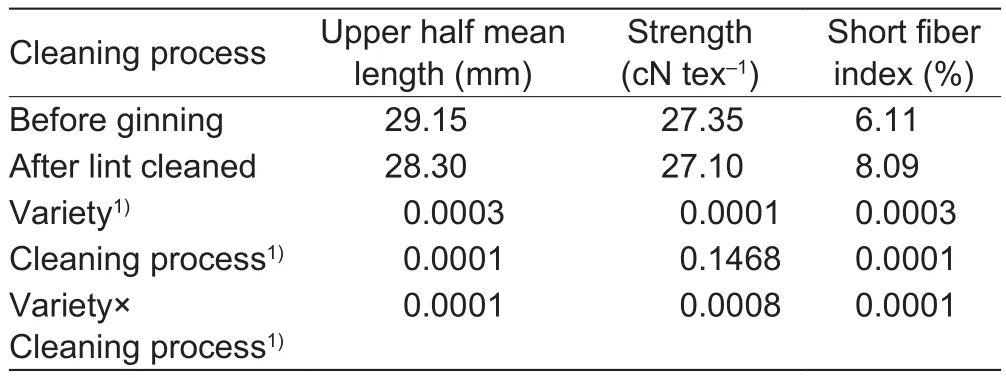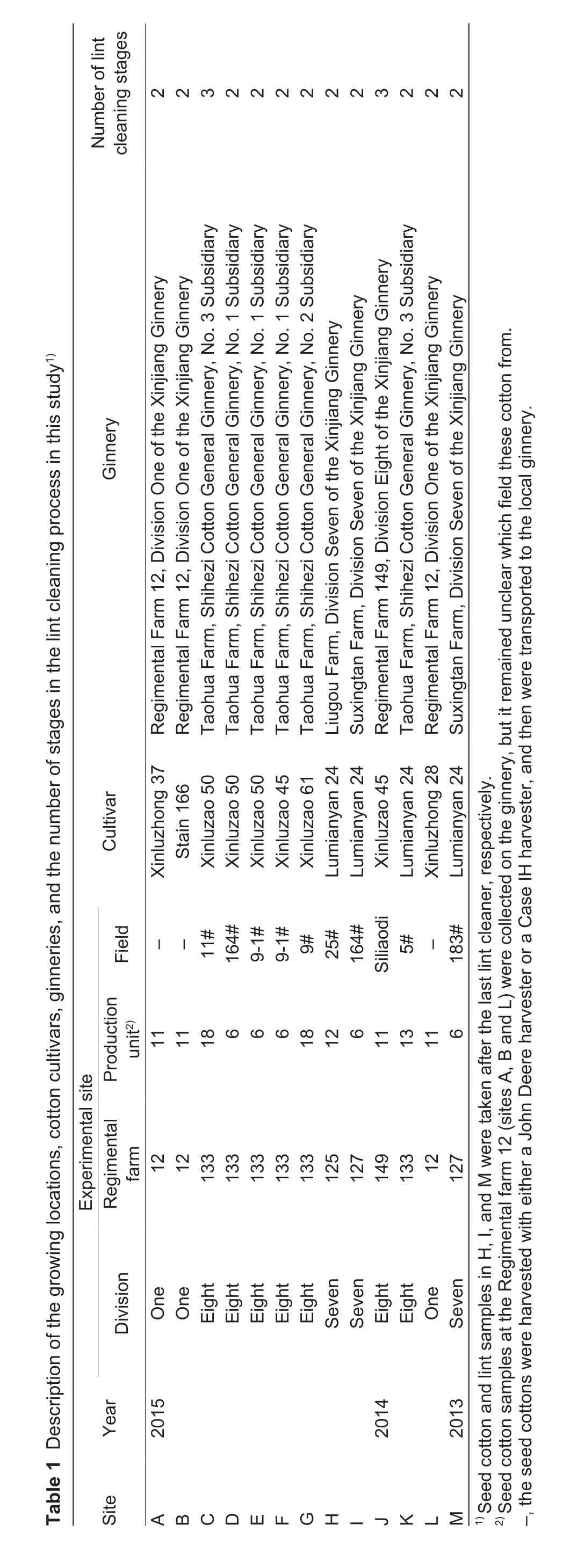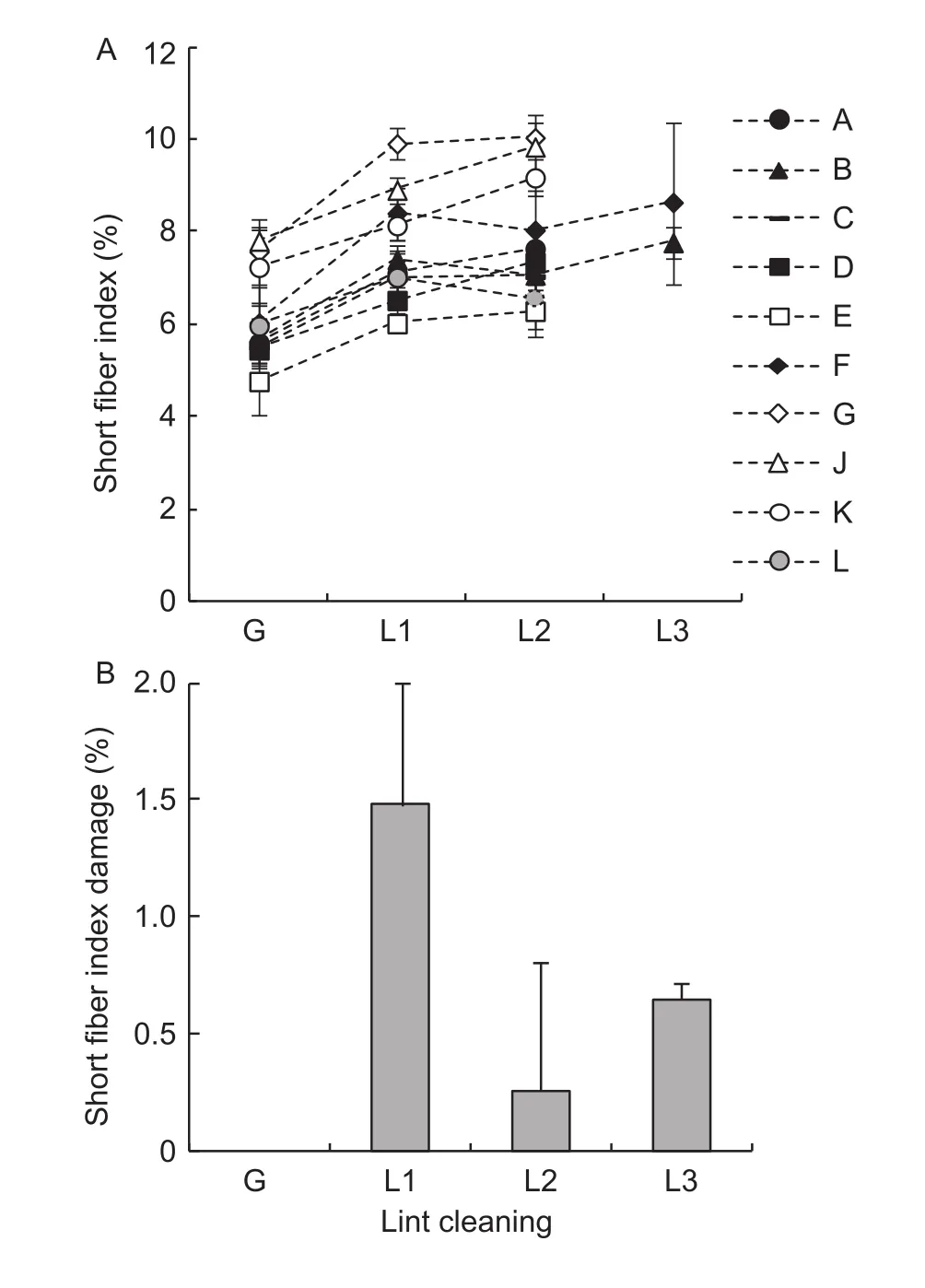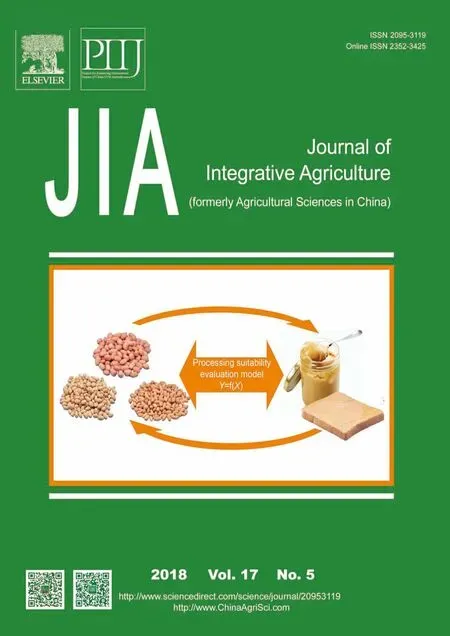Fiber damage of machine-harvested cotton before ginning and after lint cleaning
TIAN Jing-shan, ZHANG Xu-yi, ZHANG Wang-feng, LI Jian-feng, YANG Yan-long, DONG Heng-yi,JIU Xing-li, YU Yong-chuan, ZHAO Zhan, XU Shou-zhen, ZUO Wen-qing
1 Key Laboratory of Oasis Eco-Agriculture, Xinjiang Production and Construction Corps/College of Agronomy, Shihezi University,Shihezi 832003, P.R.China
2 Regimental Farm 149, Division Eight, Xinjiang Production and Construction Corps, Changji 832052, P.R.China
3 Regimental Farm 133, Division Eight, Xinjiang Production and Construction Corps, Changji 832064, P.R.China
4 Regimental Farm 12, Division One, Xinjiang Production and Construction Corps, Alaer 843301, P.R.China
1. Introduction
Cotton grows well in the Xinjiang Uygur Autonomous Region,China, whose total cotton production was 451×104t, that accounting for 73% of China’s total in 2014. Increasing labor costs in China have caused the price of hand-harvested cotton to rise, reducing China’s competitiveness in the international cotton market (Wang and Du 2006). The use of machine harvesters has increased in recent years in an attempt to reduce cotton production costs. Machine harvesting is a once-over operation, occurring when 85% of cotton bolls is in open and all of leaves are desiccated. The machines generally harvest 90% of seed cotton from plants(Hughset al. 2008). However, machine-harvested seed cotton typically has 10–30% more foreign matter than handharvested seed cotton (Kerbyet al. 1986; Hughs and Gillum 1991; Faulkneret al. 2011). Seed cotton cleaning mainly removes large foreign matter from seed cotton (Anthonyet al. 1990), while lint cleaning improves lint appearance by removing small foreign matter from lint, including neps, small leaves, seed coats, small sticks, and funiculi (Mangialardi 1992; Boykinet al. 2009).
Lint cleaners reduce availably the foreign matter content of machine-harvested cotton while improve high volume instrument (HVI) color grade and leaf grade, but damage fiber (Baker and Brashears 1999; Liet al. 2012). Many studies showed that lint cleaners significantly decreased fiber length (Dever and Grannaway 1988; Zureket al.1999; Liet al. 2012; Krifa and Holt 2013; Xuet al. 2014)and increased short fiber content (Grif fin 1979; Suiet al.2010; Liet al. 2012; Xuet al. 2014). There are mixed reports about the effect of lint cleaners on fiber strength.Some researchers reported that lint cleaners reduce fiber strength (Xuet al. 2014), whereas others reported that lint cleaners increased fiber strength (Ethridgeet al. 1995) or did not affect on fiber strength (Dever and Grannaway 1988;Krifa and Holt 2013). Fiber maturity is closely associated with fiber damage during lint cleaning. Mature cotton has less potential for fiber damage and is less affected by lint cleaning than immature cotton (Wanjuraet al. 2012; Krifa and Holt 2013). Many studies were conducted to evaluate the impact of the amounts of lint cleaners. In general,increased amounts of lint cleaners tended to improve HVI color and leaf grade (Gillum and Armijo 1997; Baker and Brashears 1999), however, these consistently decreased net returns (Mangialardiet al. 1993; Bennettet al. 1997;Nelsonet al. 1999; Holtet al. 2002) and adversely affected fiber quality (Ethridgeet al. 1995; Baker and Brashears 1999; Whitelocket al. 2011; Hughset al. 2013).
From 2008, the area of machine-harvested cotton has increased by about 10% per year in Xinjiang. In 2014, 65%of cotton area was machine-harvested. However, the lint grade of machine-harvested cotton in Xinjiang was more than two grades lower than that of hand-harvested cotton(Wang and Xu 2011; Dong 2013). Fiber quality deterioration had seriously impacted the development of Xinjiang’s cotton production. Approximately 60% cotton trading companies and textile factories in the Xinjiang indicated reluctance to buy or use machine-harvested cotton (Zhanget al. 2015).
We selected 13 cotton samples from fields that were processed in seven ginneries. The first objective was to determine how the fiber quality was affected by the ginning and lint cleaning and how the fiber damage during levels of lint cleaning changed. The second objective was to determine the optimum number of lint cleaners for machineharvested cotton based on fiber damage.
2. Materials and methods
2.1. Sampling
Seed cotton modules for this trial were obtained from prominent growers in five regimental farms in Xinjiang between 2013 and 2015. One to three cotton varieties(each in a separate module) were selected from each farm.The growers had used standard management practices for drop-irrigated upland cotton. The cotton was harvested with either a John Deere 7760 round module harvester(in Division Seven) or a Case IH CXP420 square module harvester (in Division One and Eight). The harvesters were operated according to the manufacturer’s instructions. The modules were ginned under standard commercial conditions at one of seven local ginneries. The farm sites, cultivars,ginneries, and seed cotton and lint cleaning stages are described in Table 1.
The gin was equipped with standard drying and seed cotton cleaning equipment, which included tower dryer,cylinder cleaner, stick machine, and conveyor distributor,which fed the saw gin stands, with each gin stand followed by the air-type and saw-type lint cleaners. The tower dryer was set at a 107°C mix point. The saw gin, whose ginning rate ranged from 2 200 to 3 000 kg h–1, was 406 mm in diameter and it had 171 saws. Some ginneries (sites C and J) were equipped with one air-type and two saw-type lint cleaners.The others (sites A, B, D, E, F, G, H, I, K, L, and M) were equipped with one air-type cleaner and one saw-type lint cleaner.
The seed cotton was ginned immediately after harvest.Seed cotton samples were continuously collected every 30 s before the saw gin stands and three samples (i.e.,replications) were collected. Each replication contained approximately 1 000 g seed cotton. Lint samples were continuously collected every 30 s after each lint cleaners(i.e., after the first, second, or third lint cleaner) and each replication contained approximately 500 g lint. The samples collected in the gin were taken to laboratory. The burrs and sticks were removed from the seed cotton samples, which were then ginned with a minor gin rated at 80 to 100 kg h–1. All of the lint samples, which were collected after each lint cleaner and ginning by the minor gin, were weighed, and then 100 g subsamples were removed from each replication to test fiber quality. The remainder of each sample was analyzed to determine the foreign matter content.
2.2. Determination
Fiber quality testing was conducted on a High-Volume Instrument 1 000 (Uster Technologies Inc., Knoxvile, TN),which determined fiber upper half mean length (mm), bundle strength (cN tex–1), and the short fiber index (%). The testing was done at the Supervision Inspection and Test Center of Cotton Quality of Ministry of Agriculture in Xinjiang, China.Two samples were analyzed from each replication. The foreign matter content of the cotton was tested by the Shihezi Fiber Inspection Institute, China using a Shirley Analyzer(Changzhou First Textile Equipment Co., China). Lint samples of each replication were tested one time.
3. Results
3.1. Effects of ginning and lint cleaning on fiber quality
Averaged across all 13 fields, ginning and lint cleaning had no significant effect on fiber strength (Table 2) and, averagely decreased by 0.25 cN tex–1compared with before ginning.There were seven fields (sites B, C, D, E, F, G, and L)where fiber strength was reduced after lint cleaning (but not significantly) for an average of 0.31 cN tex–1. Ginning and lint cleaning significantly reduced the fiber strength of cotton from only one field (site H) by 1.9 cN tex–1and the corresponding damage rate was 6.9% (Fig. 1). Ginning and lint cleaning significantly affected both fiber length and short fiber index.Compared with samples collected before the saw gin stands,ginning and lint cleaning reduced fiber length by an average of 0.85 mm and increased short fiber index by an average of 2.0% (Table 2). Ginning and lint cleaning significantly reduced the fiber length of cotton from 11 of 13 fields (except sites F and I), with an average decrease of 1.0 mm and an average damage rate of 3.5%. The fiber length of cotton from six fields declined by >1.0 mm. Ginning and lint cleaning significantly increased short fiber index of cotton from all fields (Table 2 and Fig. 1). The largest damage amount was 3.3% (site M).Cotton from 11 sites had damage rate >20% and one site hada damage rate of 50%.

Table 2 Mean values for fiber upper half mean length, fiber strength, and short fiber index as measured with a High Volume Instrument

?

Fig. 1 Changes in fiber length, strength, and short fiber index during ginning and lint cleaning. Fiber damage amount was calculated as the difference in quality between before the saw gin stands and the last lint cleaning. Fiber damage rate was calculated by dividing the damage amount by the fiber quality before the saw gin stands and then multiplying by 100%. * and ** indicate significances at the 0.05 and 0.01 levels of probability, respectively; ns indicates no significance. Error bar represents SD.
3.2. Effects of ginning and lint cleaning process on fiber length
Based on the above result on fiber length, the sites were divided into two groups. Group 1 consisted of cotton from fields where fiber length was significantly affected by ginning and lint cleaning (i.e., A, B, C, D, E, G, J, K, and L). Group 2 consisted of cotton from one field (i.e., F) where fiber length was not significantly affected by ginning lint cleaning. Each successive lint cleaning reduced fiber length in Group 1(Fig. 2-A). The largest decreases occurred during the first and third lint cleaning, which had length damage amounts of 0.74 and 0.35 mm, respectively. The second lint cleaning had little effect on fiber length (i.e., damage amount<0.20 mm) (Fig. 2-C). Fig. 2-B and D showed that lint cleaning had no significant effect on fiber length in Group 2,which had a damage amount of 0.13 mm.
3.3. Effects of ginning and lint cleaning process on short fiber index

Fig. 2 Changes in fiber length (A and B) and its damage (C and D) due to ginning and lint cleaning. G, fiber length before the saw gin stands. L1, L2, and L3 were the first, second, and third lint cleanings, respectively. Fiber damage amount (bar graphs, C and D) was difference in fiber length between L1–L3 and the preceding cleaning process. The samples in A and C were the sites in which fiber length was significantly affected by lint-cleaning (i.e., sites A, B, C, D, E, G, J, K, and L). The samples in B and D were the sites in which fiber length was not significantly affected by lint cleaning (i.e., site F). Error bar represents SD.
Fig. 3 shows that each successive lint cleaning significantly increased short fiber index. The second lint cleaning had little effect on the short fiber index, which had damage amounts of 0.26%. The short fiber index increased 0.65% in the third lint cleaning than the second cleaning. The greatest increase occurred during the first cleaning, which had a damage amount of 1.5%. The damage amount during the first cleaning was 5.7- and 2.3-fold higher than that during the second and third lint cleanings, respectively.
4. Discussion
4.1. Effect of lint cleaning on fiber quality
The foreign matter content of machine-harvested cotton ranges from 10–30% (Kerbyet al. 1986; Hughs and Gillum 1991; Faulkneret al. 2011). Thus, more cleaners are required to reduce the foreign matter content (Wanjuraet al. 2012) and to improve ginning efficiency and lint quality(Baker and Laird 1982). Many studies have been conducted to determine the effects of lint cleaning on cotton fiber quality. Most researchers have observed that lint cleaning caused fiber damage, especially reductions in fiber length(Dever and Grannaway 1988; Zureket al. 1999; Liet al.2012; Krifa and Holt 2013), increasing the short fiber index(Grif fin 1979; Dever and Grannaway 1988; Suiet al. 2010;Liet al. 2012; Xuet al. 2014), nep numbers (Longet al.2010). In this study, ginning and lint cleaning significantly reduced fiber length and significantly increased short fiber index. Compared with samples collected before ginning,fiber length of cotton from 11 of 13 fields was reduced significantly by 1.00 mm after lint cleaning. Ginning and lint cleaning significantly increased short fiber index of cotton from all fields. Cotton from 11 sites had damage rate >20%.In contrast, ginning and lint cleaning had little effect on fiber strength and averagely decreased by 0.25 cN tex–1. Dever and Grannaway (1988) and Krifa and Holt (2013) show that the method of ginning or lint cleaning doesn’t have significant effect on fiber strength. Ethridgeet al. (1995) indicates that the first lint cleaning causes minor decrease in fiber strength, while the second and third lint cleaning increasing fiber strength due to remove of the weaker fibers. Although multiple lint cleaning caused fiber damage to some extent,there were differences in fiber damage as influenced by the number of lint cleanings.

Fig. 3 Changes in the short fiber index (A) and its damage(B) during ginning and lint cleaning. G was before the saw gin stands. L1, L2, and L3 were the first, second, and third lint cleanings, respectively. Fiber damage amount (bar graphs, B)during lint cleaning was the difference in the short fiber index between L1–L3 and the preceding cleaning process. A–L stand for different experimental sites. Error bar represents SD.
4.2. Effect of lint cleaning amount on fiber quality
In terms of lint cleaning amounts, most ginneries use one air jet cleaner and one or two saw-type lint cleaners. Overall,one air jet cleaner has lower cleaning efficiency and causes less fiber damage than saw-type lint cleaners (Mangialardi and Anthony 1998). In this experiment, the first lint cleaning caused the greater fiber damage on length and short fiber index, corresponding damage amount were 4.7- and 5.7-fold greater, respectively, than that during the second cleaning.However, fiber damage amount during the first lint cleaning was calculated by comparing fiber quality before ginning with that after first lint cleaning. This calculation included damage amount by ginning that occurred between the last seed cotton cleaning and the first lint cleaning. Several studies have shown that processing through the gin stand can cause large decrease in fiber length and increase in short fiber index (Belet al. 1991; Suiet al. 2010; Liet al. 2012;Krifa and Holt 2013). Krifa and Holt (2013) reported that the ginning process reduced fiber length by 0.67 mm and increased short fiber index by 1.4%. In contrast, previous studies indicated that the air jet cleaner had relatively little effect on cotton fiber (Ethridgeet al. 1995; Baker and Brashears 1999). Seven ginneries sampled used the air jet cleaner in the first lint cleaning. Thus, we suggested that the fiber damage during the first lint cleaning may actually be primarily attributed to ginning. Ginnery in Xinjiang should be focused on the ginning.
The results of the present study indicated that the third lint cleaning caused greater fiber damage than the second lint cleaning. Fiber length damage and short fiber index damage during the third lint cleaning were 0.35 mm and 0.65% greater, respectively, than that during the second lint cleaning. Thus, cotton ginnery did not use strongly three lint cleanings in Xinjiang. Multiple lint cleaning intends to reduce the foreign matter, but sometime cause fiber damage and reduce lint turnout and net returns (Mangialardi 1996;Bennettet al. 1997; Baker and Brashears 1999). Some long fiber is lost to lint cleaning at all stages and at least twothirds of the fibers lose to the trash (Hughset al. 2013). The findings of previous researches support a recommendation for using one stage of lint cleaning to maximum net return(Bennettet al. 1997; Baker and Brashears 1999; Nelsonet al. 1999), especially under conditions with low foreign matter content (Wanjuraet al. 2012). This study indicated that the foreign matter content of lint was reduced to averagely 1.8% after the first lint cleaning, while the second and third lint cleaning had no significant change on the foreign matter content compared with that after the first lint cleaning (Fig. 4). Belet al. (1996) suggests that lint cleaners should be used as a step in cleaning, but most cleaning should be in the mill. Therefore, the lint should be cleaned by one lint cleaner to reduce fiber waste and associated fiber damage in Xinjiang. Anthony (2000) indicated that a stage of lint cleaning was sometimes omitted, when all seed cotton cleaning were normally used. Thus, when the foreign matter content of lint was little in Xinjiang, lint cleaning should be sometimes omitted to improve fiber quality and net returns.

Fig. 4 Changes in percent of leaf trash during ginning and lint cleaning. G was before the saw gin stands; L1, L2, and L3 were the first, second, and third lint cleanings, respectively.The cotton samples were obtained from sites A, B, C, D, E, F,G, and K. Error bar represents SD.
5. Conclusion
Ginning and lint cleaning had litter effect on fiber strength by an average of 0.25 cN tex–1. Ginning and lint cleaning significantly reduced fiber length in cotton from 85%investigated fields, with cotton from 46.2% fields exhibiting decrease by >1.0 mm. Ginning and lint cleaning significantly increased short fiber index of cotton from all fields. In cotton from 11 fields, the damage amount rate was >20%.Compared to the second lint cleaning, the third lint cleaning caused greater damage that fiber length reduced by 0.35 mm and short fiber index increased by 0.65%.
Acknowledgements
This work was supported by the National Key Technology R&D Program of China (2014BAD09B03) and the National Natural Science Foundation of China (31560366). The authors are grateful to Dr. William J. Gale, College of Agronomy, Shihezi University, China for his helpful revision of the paper especially in English language. We would also like to thanks MSc Wang Cong, Wang Wenmin, Xiao Fei, Niu Yuping, and Yang Chengxun, College of Agronomy, Shihezi University for assistance in the field.
Anthony W S. 1990. Performance characteristics of cotton ginning machinery.Transaction of the ASAE, 33, 1089–1098.
Anthony W S. 2000. Methods to reduce lint cleaner waste and damage.Transaction of the ASAE, 43, 221–229.
Baker R V, Brashears A D. 1999. Effects of multiple lint cleaning on the value and quality of stripper harvested cotton. In:Procedings Beltwide Cotton Conferences. Memphis, TN.pp. 1391–1393.
Baker R V, Laird J W. 1982. Potentials for improving stick machine performance.Transaction of the ASAE, 25,198–203.
Bel P D, Columbus E P, Bragg C K, Robert K Q. 1991. Effects of mechanical cleaning on cotton fibers. Part I: Ginning.Textile Research Journal, 61, 83–88.
Bel P D, Simpson C L, Columbus E P, Vinyard B. 1996.Effects of mechanical cleaning on cotton fibers Part II:Combinations of gin and mill cleaning- fiber quality.TextileResearch Journal, 61, 503–509.
Bennett B, Misra S, Barker G. 1997. Lint cleaning stripperharvested cotton for maximizing producer net returns.Applied Engineering in Agriculture, 13, 459–463.
Boykin J C, Armijo C B, Whitelock D P, Buser M D, Holt G A,Valco T D, Findley D S, Barnes E M, Watson M D. 2009.Fractionation of foreign matter in ginned lint before and after lint cleaning.Transactions of the ASABE, 52, 419–426.
Dever J K, Gannaway J R. 1988. In fluence of cotton fiber strength and fineness of fiber damage during cleaning.Textile Research Journal, 58, 433–438.
Dong H Z. 2013. International competitiveness of China cotton in seed industry and fiber quality.China Cotton, 40, 1–5.(in Chinese)
Ethridge D E, Barker G L, Bergan D L. 1995. Maximizing net returns to gin lint cleaning of stripper-harvested cotton.Applied Engineering Agriculture, 11, 7–11.
Faulkner W B, Wanjura J D, Boman R K, Shaw B W, Parnell Jr C B. 2011. Evaluation of modern cotton harvest systems on irrigated cotton: Harvester performance.Applied Engineering Agriculture, 27, 497–506.
Gillum M N, Armijo C B. 1997. Pima seed cotton cleaning for maximum pro fit.Transactions of the ASABE, 40, 513–518.
Grif fin A C. 1979. High-capacity ginning and fiber breakage.Textile Research Journal, 49, 123–126.
Holt G A, Baker R V, Brashears A D. 2002. Lint quality and turnout of stripper harvested cotton when bypassing the second stage extractor.Applied Engineering Agriculture,18, 411–415.
Hughs S E, Armijo C B, Foulk J A. 2013. Upland fiber changes due to ginning and lint cleaning.The Journal of Cotton Science, 17, 115–124.
Hughs S E, Gillum M N. 1991. Quality effects of current roller-gin lint cleaning.Applied Engineering Agriculture, 7, 673–676.
Hughs S E, Valco T D, Williford J R. 2008. 100 years of cotton production, harvesting, and ginning systems engineering:1907–2007.Transactions of the ASABE, 51, 1187–1198.
Kerby T A, Carter L M, Hughs S E, Bragg C K. 1986. Alternate harvesting systems and cotton quality.Transactions of the ASAE, 29, 407–412.
Krifa M, Holt G. 2013. Impacts of gin and mill cleaning on medium-long staple stripper-harvested cotton.Transactions of the ASABE, 56, 203–215.
Li C, Thibodeaux D, Knowlton A R, Foulk J. 2012. Effect of cleaning treatment and cotton cultivar on cotton fiber and textile yarn quality.Applied Engineering Agriculture, 28,833–840.
Long R L, Bange M P, Gordon S G, Sluijs M H J, Naylor G R S,Constable G A. 2010. Fiber quality and textile performance of some Australian cotton genotypes.Crop Science, 50,1509–1518.
Mangialardi Jr G J. 1992. Lint cleaning effect on seed-cotton fragment size distribution in cotton.Textile Research Journal, 62, 335–340.
Mangialardi Jr G J. 1993. Effect of lint cleaning at gins on market value and quality.Applied Engineering in Agriculture, 9,365–371.
Mangialardi Jr G J. 1996. Lint cleaning options to preserve fiber quality at gins.Applied Engineering in Agriculture,12, 555–562.
Mangialardi Jr G J, Anthony W S. 1998. Field evaluations of air and saw lint cleaning systems.The Journal of Cotton Science, 2, 53–61.
Nelson J, Misra S, Bennett B, Barker G. 1999. Gin lint cleaning to maximize producer net returns revisited.Applied Engineering in Agriculture, 15, 621–626.
Sui R X, Thomasson J A, Byler R K, Boykin J C, Barnes E M.2010. Effect of machine- fiber interaction on cotton fiber quality and foreign-matter particle attachment to fiber.The Journal of Cotton Science, 14, 148–153.
Wang L, Du M. 2006. Comparative analysis of cotton production costs in China and America.Agriculture Outlook, 7, 12–13.(in Chinese)
Wang Z J, Xu H. 2011. Survey and development proposal of machine-picked cotton in Xinjiang.China Cotton, 38, 10–13.(in Chinese)
Wanjura J D, Fanlkner W B, Holt G A, Pelletier M G. 2012.In fluence of harvesting and gin cleaning practices on Southern High Plains cotton quality.Applied Engineering Agriculture, 28, 631–641.
Whitelock D P, Armijo C B, Boykin J C, Buser M D, Holt G A,Barnes E M, Valco T D, Findley D S, Watson M D. 2011.Beltwide cotton quality before and after lint cleaning.Journal of Cotton Science, 15, 282–291.
Xu H, Cao J Q, Ye W, Xie Z L. 2014. Influence of saw type lint cleaning on performance of machine stripped cotton.Journal of Textile Research, 35, 35–39. (in Chinese)
Zhang Y B, Tian S R, Zhang Y L, Jia S Q, Xiao Q L. 2015.Survey and promotion of machine harvested cotton in Xinjiang.China Cotton Processing, 2, 18–20. (in Chinese)
Zurek W, Greszta M, Frydrych I, Balcar G. 1999. Cotton fiber length changes in the spinning process on the basis of AFIS measurements.Textile Research Journal, 69, 804–810.
 Journal of Integrative Agriculture2018年5期
Journal of Integrative Agriculture2018年5期
- Journal of Integrative Agriculture的其它文章
- Detection and characterization of an isolate of Tomato mottle mosaic virus infecting tomato in China
- Genes encoding heat shock proteins in the endoparasitoid wasp,Cotesia chilonis, and their expression in response to temperatures
- Molecular mechanisms controlling seed set in cereal crop species under stress and non-stress conditions
- Rapid semi-quantification of triacylglycerols, phosphatidylcholines,and free fatty acids in the rice bran of one grain
- lnfluence of different nitrogen application on flour properties,gluten properties by HPLC and end-use quality of Korean wheat
- Evaluation indices of sour flavor for apple fruit and grading standards
